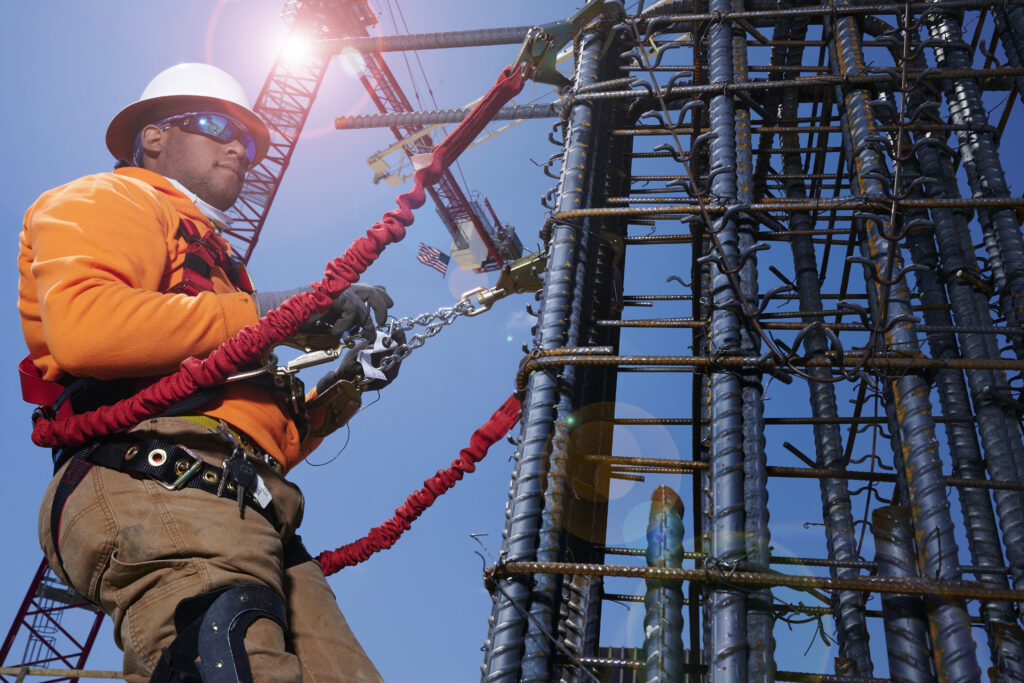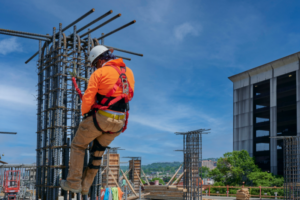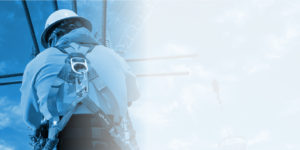Falls are the leading cause of injury and death in work-related injuries; it’s essential to properly inspect your personal fall protection equipment
It’s critical for the safety of all employees to understand how to properly inspect personal fall arrest systems prior to using the system. In an ideal world, all fall hazards would be engineered out of the workplace, though rarely is that possible. In the event of a fall hazard, it’s required by law that the employer provide a reliable personal fall arrest system to keep the employee safe. All Elk River equipment meets or exceeds the current and applicable OSHA regulations as well as ANSI and CSA Standards. Under OSHA standard §§1926.502(d)(21) and 1926.503(a)(2)(ii), fall prevention equipment must be inspected prior to each use by an employee trained in proper inspection protocol. (Source)
Components of a Personal Fall Protection System
A legal personal fall arrest system consists of at least 4 components:
- A Full Body Harness
- An Energy Absorbing Device
- An Anchorage Connector
- An Anchor
When used properly, these 4 components provide an individual with an additional level of life-saving protection by absorbing the energy of a fall.
Calculating Proper Fall Clearance
During the fall hazard identification process, each job site can present unique challenges that need to be considered during installation. Fall clearance is one of the first and most important measures to consider when addressing a fall hazard. To calculate fall clearance, you’ll need to calculate:
- Height of worker
- The initial length of the energy-absorbing device
- Deployment distance of the energy-absorbing device
- Harness Effect (This is the distance that the dorsal D-ring will slide up during a fall arrest)
- Safety Factor (Usually 3 feet)
See more in the Elk River Fall Calculation Chart PDF
Inspecting Your Fall Protection Equipment
Prior to using any safety harness or other fall protection equipment, it is the responsibility of the user to inspect the equipment. Per OSHA guidelines, this user should have been trained to complete this inspection by the competent person on the job site. OSHA defines the competent person as “one who is capable of identifying existing and predictable hazards in the surroundings or working conditions which are unsanitary, hazardous, or dangerous to employees, and who has authorization to take prompt corrective measures to eliminate them” (Source: 29 CFR 1926.32(f)).
An inspection typically consists of steps similar to those outlined below:
- To start your inspection, grab the harness by the D ring, raise it up, and shake it. This will allow the leg straps to fall into place and give you a better visual of the harness and its intended position. This will also help untwist the harness should it have been tangled up during storage.
Carefully inspect each point of the harness
- Stitches – It’s critical that all stitches are in a good, intact condition with no fraying or breaking. OSHA fail criteria consists of pulled, missing, or cut stitches, hard or shining spots, and the discoloration of stitching, depending on the cause.
- Webbing – This is the strong, narrow, and closely woven fabric that makes up the majority of the body harness. Grasp the webbing and bend both sides to create surface tension, making cuts and damaged fibers easier to see. It’s important to not only visually inspect the webbing but manually (touch) as well. Some tears and abrasions may be difficult to see with the bare eye, though they can be felt.
On the webbing, you’ll want to look for cuts, abrasions, nicks, excessive wear and tear, or water damage. Carefully inspect areas that may have come in contact with a rough or sharp surface or edge. - Hardware – It is vital to the effective operation of fall protection equipment that all hardware functions properly. This includes hooks, carabiners, and d-rings, and also includes connection configurations such as quick connects, mating buckles, and tongue buckles.
OSHA fail criteria include distortion such as twists and bends, rust and corrosion, broken grommets, additional holes or other modifications by users, broken springs, and more. - Rope – Inspecting your rope may sound like a tedious task, but it’s a critically important part of the safety inspection process. Be sure to look for frays, cuts, or other deformities that may hinder the rope from being properly and safely used. Just as the webbing, it is possible that a deformity can only be felt. Be sure to inspect the rope both visually and manually.
- Cable – Cable must be inspected for cut wires, corrosion, or kinks.
Once again, it is critical the cable is inspected both visually and manually to ensure all deformities are detected if they exist. - Check the Tagging System. Each harness must have a legible tag to identify the harness, model, date of manufacture, name of manufacturer, limitations, and warnings. This will allow you to ensure the safety harness is within its service life.
To review OSHA’s detailed harness inspection guidelines, visit here.
Be sure to read the product instructions prior to donning any personal fall protection harness or equipment.
It’s important that all OSHA guidelines are followed and employees are trained by the competent person on the job site. This article does not replace the training provided by the job site’s competent person. Additionally, all personal fall arrest system equipment is to be inspected at least once every six months, also by the job site’s competent person.
Preserving Fall Protection Equipment
The lifespan of a personal fall arrest system depends on the care given to the equipment. To increase the longevity of your Elk River safety harness, be sure to keep the equipment clean and free from dirt, sunlight, grease, oils, and other harmful materials and substances. Perform a post-wear inspection and store the equipment in a cool, dry environment, away from direct sunlight fumes, or corrosive elements.
Cleaning
It’s important to clean your harness to prevent dirt and debris from building up on the equipment. This increases the lifespan of the fall protection equipment in addition to its effectiveness
- Wipe the harness with a damp sponge
- Lather a sponge with a mild detergent and water solution
- Create a thick lather on the harness. This includes the webbing in addition to the hardware. Be sure to focus on heavy wear areas to deter debris buildup
- Wipe dry with a clean cloth and let air dry if necessary
Elk River Is Your Fall Protection Partner
All Elk River equipment meets or exceeds the current and applicable OSHA regulations as well as ANSI and CSA Standards. With nearly 30 years in the business, we are dedicated to bringing you only the most reliable, trustworthy safety protection gear. We listen to you and strive to provide the highest quality products you want, exactly when you need them. We aggressively research new designs to improve comfort, safety, and durability.
All of our Elk River harnesses and lanyards are made in the USA and trusted by industry leaders worldwide. We are proud to represent quality, safety, and tradition. Our combination of values, quality, and expertise allows us to provide the highest level of service and quality for you and your team.If there is ever a question about the integrity of the personal fall protection equipment, contact Elk River for guidance. We are your partner in fall protection, we are here to help keep you and your team safe. Contact us today.




